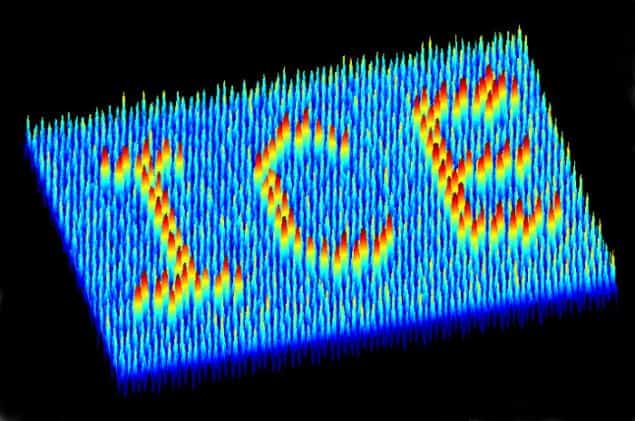
A new material called “magnetic-charge ice” has been created by physicists in the US. The magnetic properties of the material can be manipulated at the nanometre scale and the material could someday be used to encode data at higher densities than current magnetic memories. The techniques used to create and control the new material could also lead to the realization of other artificial magnetic systems.
Water ice has a tetrahedral structure that is distorted such that each hydrogen atom is shifted either towards or away from its nearest oxygen atom. The chemist Linus Pauling postulated in 1935 that, in the lowest energy lattice state, every oxygen atom has two protons shifted towards it and two shifted away. This constraint cannot simultaneously be satisfied everywhere, making ice a “frustrated” system. For other materials, such as certain mineral crystal lattices, the atomic spins also follow Pauling’s ice rules and have been dubbed “spin ices”.
In 2006 researchers led by Peter Schiffer of Pennsylvania State University created an artificial spin ice using nanometre-sized ferromagnetic particles for the individual atomic spins. This allowed them to measure the orientations of individual magnets and image directly the physics of frustration. Subsequently, researchers have shown that spin ices can be studied independently of the specific orientations of individual domains simply by considering them as lattices of north and south poles, which are considered positive and negative magnetic charges, respectively.
Broken ice rules
Now, materials physicist Yong-Lei Wang and colleagues at the Argonne National Laboratory in Illinois have created an arrangement of nanomagnets that, when placed in an axial magnetic field, give rise to a magnetic-charge ice with the same square lattice of positive and negative magnetic charges as Schiffer’s original spin ice. This occurs even though the patterns of the magnetic domains are completely different to those of the magnetic charges and do not obey Pauling’s ice rules. Therefore, one important finding of the research is that there is no unique arrangement of spins for a given arrangement of magnetic charges. “I would say that the ice rules are not relevant here,” explains Schiffer – now at the University of Illinois at Urbana-Champaign – who was not involved in the new work.
The researchers also found they could manipulate the spins in their new lattice in ways not practically possible in Schiffer’s original structure. By flipping the spins with a magnetic force microscope (an atomic force microscope with a magnetic tip), they could alter which poles were positive and which negative. The structure had eight different possible orders of the positive and negative poles, with three different energies. The researchers could switch the spins in a specific region to select the order of their choice. Subsequently, they could read back the configuration by scanning over the sample with the magnetic force microscope without applying a magnetic field.
Finally, they could also switch the spins back by reversing the direction of the applied magnetic field. Together, these processes could form the basis of a readable, writeable and eraseable memory that could be used for data storage. “In our technique, you can simply replace our atomic tip with a hard-disk recording head,” explains Wang.
Inconvenient field
However, Wang points out that the need for an axial magnetic field does complicate matters. “You need some magnet around your hard drive – that part is not very convenient for real applications,” he says. “Perhaps in future, people can derive some other method to control the spins – maybe with the help of electric current or voltage.”
The researchers’ immediate plans include exploring the research potential of the control technique they have developed to study the new material. Wang believes it may allow them to control the properties of superconductors by creating potentials that can trap magnetic-flux quanta called superconducting vortices. “When a superconducting vortex moves between such pinning potentials, the critical current and some other properties of the superconductor can change,” he says.
Materials physicist Will Branford of Imperial College London is impressed. “In the early stages of doing these sorts of artificial lattices, we were mimicking real lattices,” he explains. “Here we’re saying ‘OK, we can write whatever we want – so what else could we write?’ I think it will have a lot of impact.” Peter Schiffer agrees. “This work demonstrates, once again, the excitement around artificial spin ice,” he says. “One can design the geometrical lattice of moments to obtain interesting physics and then measure and manipulate the moments on the nanoscale.”
The research is published in Science.



